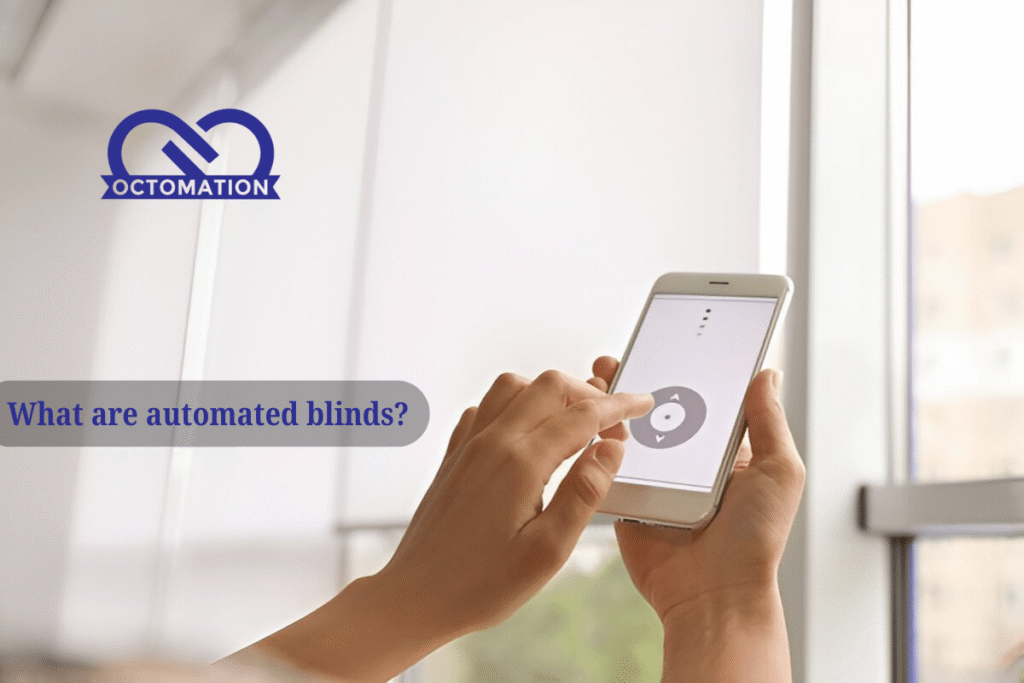What are automated blinds?

Motorized blinds, sometimes referred to as automated blinds, are a major advancement in window covering technology for homes and businesses. These cutting-edge systems provide unmatched ease, energy efficiency, and contemporary aesthetics through remote control, sensor-based, or even smartphone-integrated operation. Automated blinds have completely changed the way we use natural light automation in our homes, whether they are operated by a smartphone app, voice assistants like Alexa or Google Assistant, or timers.
How Are Automated Blinds Operational?
Fundamentally, automated blinds open and close window treatments at the push of a button using tiny motors built inside the headrail or roller mechanism. Depending on the model, these motors are driven by solar panels, wiring energy, or battery packs.
With wireless connectivity choices like Bluetooth, Wi-Fi, Zigbee, or Z-Wave, modern automatic blind systems enable users to integrate the blinds with smart home ecosystems. Dynamic and automatic management based on ambient light levels, room occupancy, or time of day is made possible by integration with smart thermostats, lighting systems, or sunshine sensors.
Automated Blind Types
Automated roller blinds
These are the most widely used types of automated blinds. A motor drives the fabric and rolls up into a cassette at the top. They provide a simple, minimalistic appearance that is perfect for contemporary spaces.
Automated Blinds in Venice
The horizontal slats of these blinds can be tilted open or closed. Precision tilting and lifting of the slats are made possible by motorized mechanisms.
Automated Roman Blinds
The fabric used for Roman blinds folds beautifully into pleats. They have silent motorized systems that rise and fall smoothly thanks to automation.
Automated Vertical Blinds
An automated track system makes it easy for vertical blinds to rotate and draw open, making them perfect for large windows and sliding doors.
Integration of Smart Homes for Automated Blinds
The potential of automatic blinds to be linked to smart home systems is one of its most potent characteristics. Voice-activated window treatment control is made possible by systems like Samsung SmartThings, Apple HomeKit, Google Home, and Amazon Alexa.
IFTTT (If This Then That) and other automation services allow users to establish custom rules, such as
“When the sun is at its strongest, close the blinds.”
“Open blinds every day at 7:00 AM.”
“At sunset, lower all bedroom blinds.”
These intelligent interactions maximize energy economy, improve comfort, and safeguard indoor items.
Advantages of Automated Blinds

Practicality and Usability
The main attraction of automated blinds is how simple they are to use. Using a voice command, smartphone app, remote control, or wall-mounted switch, users may effortlessly alter privacy and light levels.
Increased Efficiency in Energy Use
Automated blinds can react to variations in sunshine or temperature by coordinating with solar sensors or smart thermostats, which eliminates the need for artificial lighting and heating or cooling. This promotes sustainable living and lowers energy costs.
Enhanced Security at Home
Even when you’re not home, automated blinds can be programmed to open and close at specific intervals to mimic occupancy. Particularly when combined with smart lighting, this provides an additional degree of deterrence against any invaders.
Preserves Interiors and Furniture
Artwork, wood flooring, and textiles can all be faded by UV radiation. By reducing excessive exposure during the hours of greatest sunshine, automated blinds—especially those equipped with light sensors—help protect indoor furniture.
Availability
Automated blinds provide more independence for people with mobility issues by enabling simple light control without requiring physical exertion.
Battery-Powered Automated Blind Power Options
These cordless blinds are perfect for retrofitting and are simple to install and maintain. Although battery life varies according to usage, it usually lasts for several months before needing to be recharged or replaced.
Inbuilt
Hardwired blinds provide a permanent power solution with seamless integration and no maintenance needed for charging, making them appropriate for both new construction and extensive restorations.
Solar-Powered
These eco-friendly blinds are ideal for sunny areas and come with solar panels. They run effectively with little human involvement and charge all day long.
Considerations for Installation and Maintenance
For bigger or hardwired configurations, professional installation is advised, even if some automated blind systems are do-it-yourself. Important things to think about before installing include:
Access to the power source
Window compatibility and dimensions
Strength of wireless connectivity
Integration criteria for smart homes
It requires little upkeep. The majority of systems occasionally need firmware updates through mobile apps or battery replacements. Long-term operation is ensured by keeping the blinds clean with a gentle cloth and making sure there are no obstacles in the motor tracks.
The price of automatic blinds
The following factors affect prices:
Blind type (Venetian, roller, etc.)
A power source (solar, hardwired, or battery)
Intelligent traits and brand
While premium systems with complete smart home integration can cost over $800 per window, basic models start at about $200 to $300 per window. Even while the initial outlay could be substantial, the convenience and long-term savings frequently outweigh the expense.
Leading Manufacturers of Automated Blinds
Lutron
Serena Shades by Lutron, a pioneer in home automation Company in Delhi, provides excellent performance and smooth integration.
Somfy
Reliable and highly compatible with smart homes, Somfy offers motorized curtains solutions for a broad range of blind types.
The Hunter Douglas
Elegant window treatments with powerful control features and intuitive apps are available with their PowerView Automation system.
Ikea
IKEA’s Fyrtur line is accessible and reasonably priced, providing basic automation for consumers on a tight budget.
Do Automated Blinds Make Sense?
Curtain automation are a very valuable investment for anyone looking to update their house or place of business, automate daily tasks, and increase energy efficiency. Since the technology has advanced, there are now options to suit every taste in terms of design and price range.
Style, utility, and futuristic comfort are all combined in one sophisticated package with automatic blinds, whether you want to update a single room or integrate with a whole-house smart system.
Related Blogs
What is automation in lighting?
Introduction to the Growing Demand for Home Automation